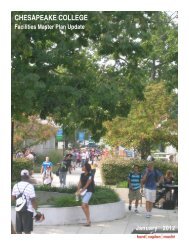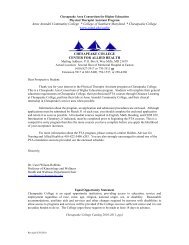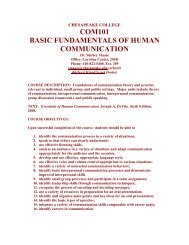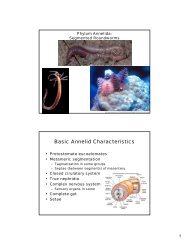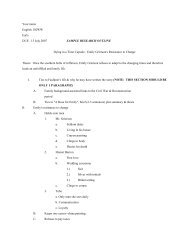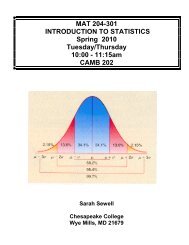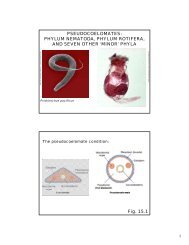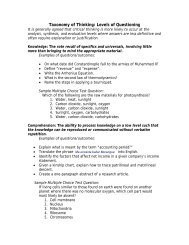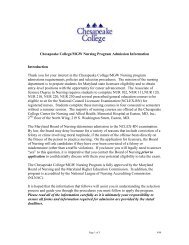Syllabus - Chesapeake College
Syllabus - Chesapeake College
Syllabus - Chesapeake College
You also want an ePaper? Increase the reach of your titles
YUMPU automatically turns print PDFs into web optimized ePapers that Google loves.
Spring 2012<br />
CHESAPEAKE<br />
COLLEGE<br />
MAT 031 –104 ELEMENTARY ALGEBRA<br />
hennayake13382<br />
Kamal Hennayake PhD (Professor of Mathematics) | Office: H-120
Course <strong>Syllabus</strong> for MAT 031 - 104 Spring Semester 2012<br />
COURSE NAME: Elementary Algebra<br />
INSTRUCTOR: Dr. Kamal P. Hennayake<br />
OFFICE: H - 120 Phone: 410 – 822 – 5400 x 312 Email: khennayake@chesapeake.edu<br />
OFFICE HOURS: Monday and Wednesday: 1:00 pm – 2:30 pm;<br />
PREREQUISITE: MAT 023 or appropriate score on the placement test.<br />
COURSE DESCRIPTION: “An introduction to algebra. Topics include properties of whole<br />
numbers, integers and rational umbers; solving equations; polynomials; factoring; systems of<br />
equations and graphs. ”<br />
(Three hours per week), three load hours, 0 credits.<br />
REQUIRED COURSE MATERIALS:<br />
TEXTBOOK: Beginning Algebra by ElaynMartin-Gay. Pearson Prentice Hall. 2009 ISBN # 0-13-<br />
600702-3. Make sure you have My Math Lab (MML) access code with the textbook.<br />
Everyone needs a pencil and a notebook to keep a very good set of notes, and a separate<br />
notebook to do the homework.<br />
Now that you have decided to take this course, remember that a positive attitude will<br />
make all the difference in the world. Your belief that you can succeed is just as important as<br />
your commitment to this course. Make sure that you are ready for this course by having the<br />
time and positive attitude that it takes to succeed.<br />
In this course you will study:<br />
o Solving Equations and Inequalities<br />
o Graphing Equations and Inequalities<br />
o Solving Systems of Linear Equations<br />
o Exponents and Polynomials<br />
o Problem Solving<br />
o Factoring Polynomials<br />
This course is intended to provide a useful background in mathematics for students pursuing<br />
any degree or certificate. This is the middle step in your non-credit mathematics. This is<br />
approximately equivalent to the first year of high school algebra. In this course, you will learn<br />
many new concepts and see the expansion of several familiar ones. All the topics in this course<br />
are designed to prepare you for subsequent courses in Mathematics. You will be doing some<br />
applications that will help you understand the relevance of what you are learning. As your<br />
mathematical expertise expands in succeeding courses, the applications of your skill will<br />
become even more diverse and interesting. Your ability to succeed in those later courses will<br />
very much depend on how well you understand the material covered in this course.<br />
In addition to the class time, the average student should plan to spend six hours outside of<br />
class each week (2 hours for every hour spent in class). Students whose background in<br />
mathematics is below average, or who normally work at a slower than average pace; should<br />
schedule more time in order to keep up with the course material.<br />
In order to comfortably succeed in MAT 031 you will need to be proficient in the following skills.
If you need to brush up on any of these skills please ask for help immediately!<br />
o Basic number sense<br />
o Add, subtract, multiply and divide integers and fractions<br />
o Use of exponents and the order of operations<br />
o Arithmetic operations of sign numbers<br />
Attendance: Research shows that attendance is the single most important factor in school<br />
success. Most students need guidance in understanding the procedures involved in developing<br />
a new mathematical process. If you find yourself unable to keep up with the class, make an<br />
appointment immediately to see the instructor outside of class time. Learning builds day by<br />
day. If you miss a day of class, you miss a day of learning. Material learned on one day is used<br />
the next day and the next day, and so forth. It is very difficult to catch up when you miss one<br />
day and fall behind. It is the student's responsibility to make up any work missed due to an<br />
absence for any reason.<br />
Academic Honesty: As described in the Student Code of Conduct, “If based on substantial<br />
evidence, a student is deemed guilty of academic dishonesty, the <strong>College</strong> may initiate<br />
disciplinary action as follows:<br />
1. The student may be required to repeat the assignment or the examination.<br />
2. The student may be given a failing grade for the assignment or the examination.<br />
3. The student may be given a failing grade for the course.<br />
The student may be suspended or dismissed from the college. The <strong>College</strong> has a policy on<br />
academic honesty. You are expected to abide by the procedures set forth in the document. (For<br />
more information you may visit http://www.shesapeake.edu/sched_cat/catpdf/intro.pdf for<br />
the actual policy).<br />
Accommodating Disabilities: Any student in this course who has a disability, which may<br />
prevent him or her from fully demonstrating his or her abilities, should contact the instructor as<br />
soon as possible. So we can discuss accommodation necessary to ensure full participation and<br />
facilitate your educational opportunity. (For more information you may visit<br />
http://www.chesapeake.edu/services_student/disabilities.htm).<br />
<strong>College</strong> policy prohibits young children from accompanying parents to class.<br />
Classroom Etiquette: It is assumed that all students will respect each other’s rights to fully<br />
participate in the discussion of the day. To that end, it is expected that students will not engage<br />
in behaviors that distract not only the instructor but also their fellow classmates. Students who<br />
engage in activities such as talking to each others, talking on cell phones or text messaging,<br />
leaving class for non-emergency needs, will be asked to leave. If you are unlucky enough to be<br />
one of these students, you will be required to meet with me in my office prior to returning to<br />
class. I expect that all of my students will behave in an adult, respectful and professional<br />
manner. Students are prohibited from using, activating or displaying personal electronic<br />
devises.
GRADES: The numerical final course grade will be computed as indicated in the following<br />
distribution, and letter grades will be assigned as follows.<br />
Components of Final Grade<br />
Homework/quizzes (MML) 20%<br />
Tests 60%<br />
Final Exam 20%<br />
Letter Grade Percentage:<br />
A 90% or above<br />
B 80% to 90%<br />
C 70% to 80%<br />
F Below 70%<br />
TESTING: Dates for tests are given on the syllabus. You should make a special effort to be present for<br />
class on those days, but should it be absolutely necessary to miss a scheduled test, the student<br />
should contact the instructor as early as possible to make other arrangements for testing. A separate<br />
make-up test will be given only for an extreme emergency, and will be scheduled at the instructor's<br />
convenience.<br />
If you are absent prior to a scheduled test, you will still be expected to take the test at the scheduled<br />
time and are expected to contact a classmate or the instructor in advance to obtain the information<br />
required to prepare for the test.<br />
Homework/Quizzes:<br />
You are expected to study practice problems outside the class. This may help you to check whether you<br />
had understood the information from each lesson. You do this work in My Math Lab (MML).<br />
Final exam is a comprehensive exam. Everyone must take it in class.<br />
Although you will be tested on the subject matter of each chapter, tests for specific sections may be<br />
combined so as to maximize course effectiveness. The following outline may be modified slightly as<br />
necessary to accommodate student needs and to permit possible computer and/or video<br />
demonstrations. A brief description of the Objectives for each chapter is detailed on the following<br />
pages. This course consists of all or parts of chapters #2, #3, #4, #5, and #6 in the assigned textbook. The<br />
following syllabus outlines in detail the material, which will be presented from each of the chapters, and<br />
the intended order of presentation.<br />
COURSE OUTLINE<br />
CHAPTER<br />
Two<br />
Three<br />
Four<br />
Five<br />
Six<br />
TOPIC COVERED<br />
Equations, Inequalities, and Problem Solving<br />
Graphing<br />
Solving Systems of Linear Equations and Inequalities<br />
Exponents and Polynomials<br />
Factoring Polynomials
Learning Outcomes Students will be able to:<br />
1 Perform calculations with integers.<br />
2 Solve applied problems by writing the appropriate equation and solving it appropriately.<br />
3 Add, subtract. Multiply and divide polynomials.<br />
4 Perform operations with exponents.<br />
5 Use equations and inequalities to solve problems.<br />
6 Evaluate exponents written in function notation.<br />
MAT 031-104 Elementary Algebra Spring Semester - 2012<br />
Day Date Section Extra Practice Problems (Not for Grading)<br />
1 Jan 23<br />
2.1 Simplifying algebraic expressions pg 79: 1, 9, 11, 15, 17, 21, 23, 31, 33, 41, 45, 49, 65, 67, 81<br />
2.2 Addition property of equality pg 87: 3, 7, 9, 11, 17, 19, 21, 23, 25, 27, 37, 39, 43, 63, 67<br />
2 Jan 25<br />
2.3 Multiplication property of equality pg 95: 5, 13, 25, 27, 41, 45, 51, 63, 73, 75, 79, 81, 83, 85, 87<br />
2.4 Solving linear equations pg 103: 1, 3, 9, 17, 21, 23, 25, 37, 43, 47, 61, 69, 73, 77, 85<br />
3 Jan 30 2.5 An introduction to problem solving pg 101: 1, 5, 7, 9, 17, 23, 25, 29, 31, 33, 35, 37, 39, 43, 47<br />
4 Feb 1 2.6 Formulas and problem solving pg 122: 1, 3, 5, 9, 13, 15, 19, 21, 29, 31, 33, 35, 41, 47, 53<br />
5 Feb 6 Test 1 Pg 105: 1, 5, 9, 13, 17, 21, 25, 29, 33, 35<br />
6 Feb 8 2.7 percent and mixture problem solving pg 134: 1, 7, 11, 15, 21, 23, 29, 35, 39, 43, 45, 61, 77<br />
7 Feb 13 2.8 Further problem solving pg 143: 5, 7, 9, 13, 21, 25, 29, 31, 33, 35, 37, 39, 43<br />
8 Feb 15 2.9 Solving liner inequalities pg 153: 1, 3, 9, 11, 15, 17, 21, 23, 25, 29, 31, 33, 41, 43, 45, 51, 57<br />
9 Feb 20 3.1 Reading graphs and RCS pg 180: 1, 7, 19, 21, 23, 25, 31, 33, 35, 39, 47, 49, 51, 57, 59<br />
10 Feb 22 3.2 Graphing linear equations pg 191: 1, 5, 7, 11, 17, 19, 21, 25, 27, 33, 37, 41, 47, 51<br />
11 Feb 27 Test 2 Chapter 2 Test; page 116<br />
12 Feb 29<br />
3.3 Intercepts pg 200: 5, 9, 15, 23, 25, 27, 29, 31, 35, 39, 43, 47, 53, 55<br />
3.4 Slope and rate of change pg. 213: 3, 5, 9, 15, 23, 25, 29, 31, 35, 39, 41, 43, 47, 51<br />
13 Mar 5 3.5 Equations of lines pg 224: 1, 7, 11, 15, 21, 23, 29, 35, 39, 43, 45, 61, 77<br />
14 Mar 7 3.6 Functions pg 234: 3, 7, 9, 11, 17, 19, 21, 23, 25, 27, 37, 39, 43, 63, 67<br />
15 Mar 19 Test 3 (Mid Term) Chapter 3 Test; page 246<br />
16 Mar 21<br />
4.1 Solving systems of equations by graphing pg 256: 1, 5, 7, 11, 15, 17, 19, 21, 23, 25, 39, 45, 49<br />
4.2 Solving by substitution pg. 263: 1, 5, 7, 9, 11, 13, 15, 17, 19, 23,35, 37, 41<br />
Mar 23 Mid-term Grades Due<br />
17 Mar 26 4.3 Solving by addition pg 269: 1, 3, 5, 7, 9, 15, 17, 19, 21, 25, 27, 31, 39, 45, 51<br />
18 Mar 38 4.4 Systems of equations and problem solving pg 278: 1, 3, 5, 7, 11, 17, 19, 25, 31, 35, 43, 49, 53<br />
19 Apr 2 Review for Test 4 Pg 296: 3, 9, 11, 15, 17, 25, 27, 31, 33<br />
20 Apr 4 Test 4 Chapter 4 Test; pg 298<br />
21 Apr 9<br />
5.1 Exponents pg. 310: 7, 9, 15, 19, 21, 29, 39, 43, 55, 63, 67, 75, 79, 91, 95<br />
5.2 Adding and subtracting polynomials pg. 320: 5, 7, 11, 19, 23, 27, 31, 45, 49, 53, 61, 63, 71, 77, 83<br />
22 Apr 11 5.3 Multiplying polynomials pg 327: 5, 9, 13, 23, 25, 27, 29, 33, 41, 55, 61, 69, 79, 83, 89, 91<br />
Apr 19 Last Day to drop a class with W grade<br />
23 Apr 16<br />
5.4 Special products pg 334: 3, 17, 23, 31, 35, 37, 39, 41, 47, 49, 51, 53, 55, 57, 61, 77<br />
5.5 Negative exponent and scientific notation pg. 343: 5, 9, 11, 13, 17, 23, 29, 35, 39, 45, 53, 57, 59, 61, 67, 71<br />
24 Apr 18 5.6 Dividing polynomials pg 350: 5, 9, 15, 21, 27, 37, 41, 55, 61, 63, 77, 79
25 Apr 23 Test 5 Chapter 5 Test; page 359<br />
26 Apr 25 6.1 The GCF and factoring by grouping pg. 369: 7, 9, 13, 15, 19, 27, 31, 39, 49, 53, 59, 61, 67, 71, 73, 75<br />
27 Apr 30 6.2 Factoring Trinomials pg 376 5, 9, 21, 27, 29, 31, 33, 35, 39, 41, 45, 57, 69, 73<br />
28 May 2 6.3 Factoring Trinomials pg. 310: 7, 9, 15, 19, 21, 29, 39, 43, 55, 63, 67, 75, 79, 91, 95<br />
29 May 9 Comprehensive Final Examination 9:30 – 11:30 am<br />
This is a tentative schedule. It is subject to change.<br />
REVIEW SHEET FOR THE FINAL EXAMINATION<br />
The final examination for this course consists of fifty computational questions. The problems<br />
are similar to those that you have worked to complete each unit and similar to the questions you<br />
experienced on each quiz. Practice working out exercises by completing the Chapter Review found at<br />
the end of each chapter. Further, you may find it beneficial to review the Chapter Highlights at the end<br />
of each chapter. There you will find an example of each of the concepts. If you have any difficulties you<br />
should review that section of the chapter more thoroughly. Make sure you allow yourself plenty of time<br />
to prepare for a test. Review all homework, quizzes and tests. If you have any questions, be sure to ask<br />
before you take the final examination.<br />
A suggested list of topics that you should review includes, but is not necessarily limited to:<br />
1 Combine like terms in a given expression.<br />
2 Solve linear equations, linear inequalities and literal equations.<br />
3 Use formulas to solve problems and solve a formula or equation for one of its variables.<br />
4 Solve mixture, percent, discount, and mark-up problems.<br />
5 Solve problems involving distance, money, and interest.<br />
6 Graph linear equations.<br />
7 Identify slope and intercepts of a graph and/or of a line given two points of the line.<br />
8 Compare the slopes of parallel and perpendicular lines.<br />
9 Given sufficient information write the equation of a straight line.<br />
10 Identify functions and use function notation.<br />
11 Solve a system of linear equations by graphing, by substitution, and by addition.<br />
12 Use a system of equations to solve problems.<br />
13 Evaluate expressions containing positive, and negative exponents<br />
14 Add, subtract, and multiply polynomials.<br />
15 Divide a polynomial by a monomial.<br />
16 Use long division to divide a polynomial by another polynomial.<br />
17 Solve all type of application problems.<br />
18 Factor out a GCF from a polynomial.<br />
19 Factor a polynomial by grouping.<br />
20 Factor trinomials.



